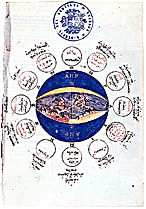 |
|
 |
Barlaam of Calabria and the Palaiologan Renaissance
 n spite of its solid adherence to the Christian faith, Byzantine culture during its entire history from
n spite of its solid adherence to the Christian faith, Byzantine culture during its entire history from
 the 9th to the 12th century, had to face an almost permanent internal conflict. On the one hand, the common language, tradition, education and a philosophical interest, led many Byzantine scholars to the study of Greek antiquity. the 9th to the 12th century, had to face an almost permanent internal conflict. On the one hand, the common language, tradition, education and a philosophical interest, led many Byzantine scholars to the study of Greek antiquity.
On the
other hand, classical studies were always strongly criticised, especially by the Church and the monks in particular, who believed that ancient Greek literature and philosophy were pagan creations and were therefore dangerous for Christians. These two conflicting groups were still active in the Byzantine society of the late 13th century and were about to witness a remarkable revival. While monasticism and the Church were beimg spiritually re-invigorated through the hesychast movement of the late Byzantine period, the study of the Greek Classics, promoted by eminent personalities, was going through what was termed the Palaiologan Renaissance.
One of these scholars and the main opponent of the hesychast movement, was
Barlaam of Calabria,
a Greek monk from southern Italy, who, shortly before 1328, had gone to Constantinople to see the land of Aristotle and Plato. Barlaam, who had studied in Rome, was the author of a number of scientific and philosophical works. The daring and rational philosophical proposition he put forward, on questions that had already been posed by many Byzantine
humanists was the following: since
the writings of the ancient Greek philosophers are worth reading and
copying,
since they are taught at schools and universities and since, therefore, certain ideas of Classical antiquity are part of the heritage of universal wisdom, why not apply these ideas to theology and to the entire area of religion?
See also: Education
|